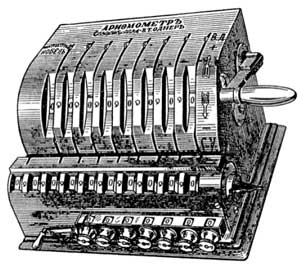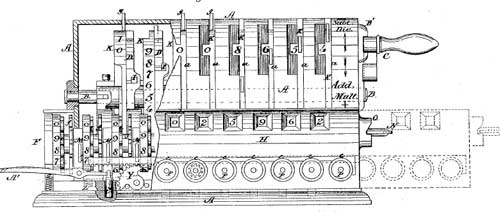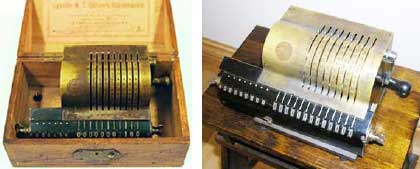Who Was Willgodt Odhner?

Willgodt Odhner was a Swedish inventor and engineer. He invented a mechanical calculator and founded a factory in St. Petersburg in 1880. By the 1940s, his invention- the Odhner Arithmometer, was a top-rated portable mechanical calculator worldwide. His invention was a massive success, and the production of the calculator went on until 1970.
No matter when Odhner commenced his arithmometer, the prototype was finished at the end of 1875. The device was a pin-wheel-based calculator, housed in a rectangular wooden box and calculating with 8-digit precision. Odhner however didn’t consider this device as his first calculator (maybe it was too bad, or it relies too much on the ideas of Staffel or somebody else), because later on will write, that his first machine was manufactured in 1876, when was produced the second prototype (again pin-wheel, but with 8 digit precision).

Early Life
The Swedish mechanic and inventor Willgodt Theophil Odhner was born in Westby, parish of Dalby in northern Wärmland province of Sweden, on 10 August 1845, as the firstborn in the family of the forester and surveyor Theophil Dynamiel Odhner (1816-1863) and Fredrika Sofia Wall (1820-1874). Theophil suddenly died at the age of 46, leaving a poverty-stricken widow and five young children behind him, with a sixth to arrive three months later. Odhner’s mother was a very intellectual and poetic woman who struggled bravely to bring up her children amid much poverty.
Willgodt attended the school of Karlstad for two years 1854-1856. After that, he moved to Stockholm to work at the lamp store of his uncle Aron Odhner. Soon he changed to a more challenging position as an employee of the instrument maker Georg Lyth. On 3 September 1864, Willgodt Odhner matriculated at the Kungliga tekniska högskolan (the Royal Institute of Technology in Stockholm) to study practical mechanics and mechanical technology. Odhner was promoted to the third year’s class in 1866 but never finished his studies and left the school during the spring of 1867.
At the end of 1876, Odhner tried to convince his boss—Ludvig Nobel, to start the production of the calculator. Nobel made a deal with Odhner for producing 14 calculating machines. The capacity of these was 10 instead of 9 of the ”first” model. Nobel has given Willgott the use of a small portion of the factory to work with his machine and the production began at the beginning of 1877. Nobel and Willgodt have made an agreement that Nobel shall carry all costs to see the business started and until then he is paying Willgodt a salary on the condition that when the business has started they shall share for better or worse and take one-half of the profits. These first Odhner’s factory-made calculators finished in the latter half of 1877 (see the drawing below), and a total of 14 machines were built. Later on, however, Nobel lost his interest, and production ceased.

At the beginning of 1878, Odhner left one of his calculators to be refereed by the Imperial Russian Technical Society. He might have hoped to receive a state prize like the earlier Russian (in fact Polish Jews, but then part of Poland belonged to the Russian empire) calculator inventors Slonimski and Staffel had got.
Career
Mechanical Workshop of Macpherson
The financial situation in Sweden was quite bad in 1868, and it was challenging to find a job. Thus Odhner decided to try his luck in St. Petersburg, Russia. He arrived at St. Petersburg by steamboat at the age of 23 without knowing a word of the Russian language and having only 8 roubles with him. He arrived in Russia at the end of 1868 or 1869. From the harbor, Odhner walked to the Swedish consulate where secretary Damberg, who later became consul, arranged for him a job at the small mechanical workshop of Macpherson at a salary of 1.1 rubles a day.
Expedition
After some months, Odhner changed to work for his countryman Ludvig Nobel (Ludvig Nobel (1831-1888), one of the most prominent members of the Nobel family. Ludvig was a remarkable engineer, a noted businessman, and a humanitarian) in his machine factory on the recently started rifle conversion project. The time that Odhner worked for Ludvig Nobel was significant for Odhner’s later career. Nobel did not appreciate diplomas and final examinations, and thus, it did not matter that Odhner had not completed his studies. He advanced soon to be a foreman and chief foreman.
Odhner started to design his arithmometer probably in 1874, and the prototype was finished at the end of 1875. It was not very easy to design a calculator in one’s scant spare time.” To work from 7 in the morning to 8 in the evening is not very nice for a poor newlywed man having a young and beautiful wife”. Twelve or fourteen hours a day was a common workday in Russia, but Nobel reduced it to 10.5 hours but may be somewhat later. Odhner’s first child Alexander was born in 1873. His mother had come to St. Petersburg to see the birth of her first grandchild and died there in 1874. Odhner’s efforts were reported in an article that appeared in the newspaper St. Petersburger Zeitung on 10 September 1875.
After the agreement with his boss—Nobel, to start the machine’s production in the factory, Odhner again met many personal and official difficulties. Their relations of Odhner with the directors of the factory were quite bad. Odhner had to go into debt to finance his living. At this time, he had two children to take care of, Alexander born in 1873, and Alma, born in 1877. Earlier in 1877, Emilia—the second child of Odhner died at two years. The political and economic situation in Russia was not good. In the same 1877, a war between Turkey and Russia opened, so Nobel started to lose interest in the project for calculators. Thus Odhner started to ask for a new investor, and he found one. As he writes, I believe a particularly energetic local businessman, a certain Königsberger, on the condition that he takes the patents and pays all expenses and afterward divides with me the future profits. However, I couldn’t get anything in cash. This would have been so welcome because I am now unemployed.
Business
In addition to manufacturing calculators, Odhner was also a successful entrepreneur. In 1882 Odhner started his own business to produce a paper cut in special forms, together with his brother Sannfrid and an Englishman, working in the Expedition. Odhner designed and constructed different paper-cutting devices for the job. It is not known what happened to the paper business after 1882, but evidently, no great fortune was made with it. In the same 1882, Odhner constructed a turnstile for counting and controlling ticket sales, which was later widely used for passenger steamships operating on the canals of St. Petersburg and also in amusement parks.
The production palette of Odhner’s factory varied, and of the various products, one can mention cigarette machines designed by Odhner capable of producing 4000 cigarettes in an hour, Orlov printing presses, small mechanical precision instruments, and castings of brass, aluminum, and cast iron. In addition to these, other production included turnstiles for ships and amusement parks, control systems for trains, gramophones, and on the military side, sights, rangefinders, and munitions cartridges for artillery. The bestseller of Odhner’s factory certainly was not the arithmometer but the Orlov printing press.
What Was WiIlgodt Odhner Known For?
Odhner Arithmometer
The Odhner Arithmometer was one of the famous inventions by Willgodt Odhner. Its production officially began in 1890 in Odhner’s Saint Petersburg workshop. He planned to manufacture a small and simple calculator that was portable and easy to use. He built on the concept of French physicist Blaise Pascal (who constructed the first calculator) and other constructions by subsequent inventors to manufacture a cheap and practical calculator. In 1876, Odhner released the first model of his calculator, which he later patented in 1878 in Germany and the following year in Sweden.
In 1887, Odhner was granted official permission to open his workshop, which would later become the W. T. Odhner factory in St. Petersburg. In the beginning, the only machine in the workshop was an old pedal-driven lathe and several workers. In 1889, a cousin of Odhner, engineer Valentin Odhner, who had graduated from the Royal Institute of Technology in Stockholm, joined the staff. Odhner’s older son, Alexander, was the commercial assistant. In 1890, when the production of arithmometers began, the workshop had one 2 H.P. steam engine, the number of workers was 20, and the annual production value was 11000 roubles. Only 2 years later, in 1892, the workshop had one 4 H.P. petroleum motor, 20 various lathes, 25 workers and ten children, and an annual production value of 30000 roubles.
In 1890, Odhner took all the rights for his machine from Königsberger and was granted a new Russian patent for an improved machine. The input was now read from the cover, not from the pinwheels, and the clearing mechanism of the revolution register (counter) was better. Inside the calculator, Odhner had added an extra pinion between the pinwheel and the number wheel. The pinwheel is also more compact than the previous version and resembles much of Wertheimber’s 1843 patent. The patents were also registered in France (Nr. 261806, 1890), Luxemburg (1890), Belgium (Nr. 91812, 1890), Sweden (Nr. 3264, 1890), Norway (Nr. 2117, 1890), Austria-Hungary (Nr. 45538, 1890), England (Nr. 13700, 1891), Germany (Nr. 64925, 1891) and Switzerland (Nr. 4578, 1892), USA (Nr. 514725, 1894). In 1893 the arithmometer was exhibited with success at the World’s Columbian Exposition in Chicago. In the same 1890, Odhner started a powerful publicity campaign for his new calculator and mass production of the machine.

The dimensions of the first machines of Odhner are: 29 x 11,7 x 14,8 cm, and the weight is 6,3 kg.
Let’s examine the principle of action of the pin-wheel machine using the patent drawing (see below):

The mechanism consists of two disks: basic (called counting wheel), which has 9 grooves with fingers (marked with) with projections. Over the basic disk is mounted a thin disk (called input disk) with grooves, which are pushed into the projections of the fingers of the basic disk. The input disk can be rotated by means of a crank, and as the groove is in the form of two arcs with different radiuses, when the projection is pushed in the lower, then the finger is in the lower position, and when the projection is pushed in in the arc with bigger radius, then the appropriate finger is in upper condition and is stuck out of the periphery of the basic disk. Thus, if we want for example to enter 5, we have to rotate the input disk so, 5 fingers from the counter disk are stuck out.
After all the digits are entered, then the main crank (the big crank in the right part of the machine), and all disks will be rotated according to the number of stuck-out fingers of the appropriate counter disk, then the registration disk, which is connected to a 10-teeth pinion will be engaged with the fingers and will be rotated to the proper angle. During this rotation the counter and the input disk are rotated together, so the entered number is kept. Newer models have levers for resetting the input and registration mechanisms. The teeth of the figure are part of the ten-carry mechanism. The cylindrical keys P, which can be seen in the front lower part of the body, is revolution counters for the appropriate counter and input wheels. The mechanism with registration wheels is mounted as a separate block and can be moved leftwards and rightwards according to the mechanism with counter and input wheels by means of a slider. This is necessary during multiplication and division.
The adding operation is performed, as the addends are entered consecutively by means of the levers of the input wheels, as the entered number can be seen in the upper row of windows, and by rotating the main crank these numbers are transferred downwards to the registering wheels, and the result can be seen in the lower row of windows.
The subtraction is done in a similar way, but after the minuend was transferred to the registration wheels and the subtrahend is entered in the input wheels, the crank must be rotated in the opposite for the adding direction.
The multiplication is done by consecutive adding. First, the bigger factor is entered by means of the input wheels, then the lever must be rotated so many times, according to the units of the other factor. Then the registration mechanism is moved rightwards by means of the slider, and the lever is rotated so many times, according to the tens of the other factor, and so on until are used all digits of the other factor. The result can be seen in the lower windows.
The division is done by consecutive subtraction. Let’s examine the example, given in the patent of Odhner, 285582/8654=33. First, we enter the dividend and transfer it by rotating of the crank to the middle row of windows (registration mechanism). Then set up the divisor, and adjust the slide one place to the right, until the first digit (8) of the divisor is directly over the second digit (8) of the dividend, counting from the left. Then turn the crank backward or to the right until the first digit (8) of the divisor can no longer be subtracted from the digits in the dividend which under and to the left of it. The number 3, which is the first digit of the quotient, will then appear on the second cylinder, and the dividend will be reduced to 25962, The slide is next moved one place to the left, or back to its original position, and crank again rotated until the dividend disappears and a line of zeroes stands in its place. Figure 3 will then appear on the first cylinder, P, making the second figure of the quotient sought—to wit, 33. It will be seen, that the result indicates that the divisor, 8654 is contained three times in the first five figures, 28558, of the dividend, and three times in the new or second dividend, 25962.

WiIlgodt Odhner: Marriage, Children and Personal Life
Net worth
Odhners exact net worth is not known. However, before the 1904-1905 Russo-Japanese war, Odhner’s factory received great orders from the Government for fine machinery connected with guns. These orders made Odhner quite a wealthy man.
Marriage & Children
In 1871, Willgodt married Alma Skånberg (1853-1927) (later on, they were blessed with 8 children)
Awards and Achievements
In 1881, after three years of work, Odhner received a great gold medal for his innovations. In addition, Odhner was also highly esteemed in the hierarchy of the Expedition. Although he was officially registered as a master technician, he received the higher salary of an engineer.